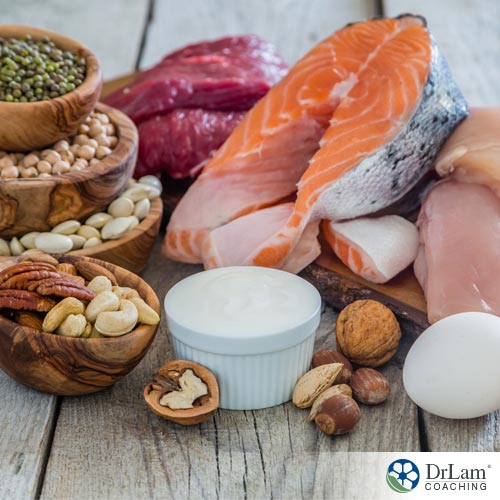 Protein is a vital nutrient that your body needs to thrive. How you fulfill this need is up to you, and there are plenty of options to choose from. Adding a variety of protein sources to your diet is wise, as each contains their own individual nutrient profile and a combination of amino acids. Your body needs a variety of both to be at its healthiest. Knowing all your options and understanding the best protein per serving foods can help you add flavor and variety to your diet.
Protein is a vital nutrient that your body needs to thrive. How you fulfill this need is up to you, and there are plenty of options to choose from. Adding a variety of protein sources to your diet is wise, as each contains their own individual nutrient profile and a combination of amino acids. Your body needs a variety of both to be at its healthiest. Knowing all your options and understanding the best protein per serving foods can help you add flavor and variety to your diet.
Protein is one of the building blocks of life as its presence in the body is essential to cell regeneration and repair, and building muscles, cartilage, skin, and blood. It is a part of every cell, and the body would cease to function without some source of it to work with. The body actually needs large amounts of protein to sustain itself which classifies it as a macronutrient. The body needs it to be delivered consistently by external sources to nourish the system. If you are craving protein, it’s probably for a good reason.
Just as protein is one of the primary building blocks of the human body, amino acids are the building blocks of all proteins. The amino acids are linked together in the protein molecule in a unique fashion known as peptide linkage. Upon digestion, the protein is split into its component amino acids, which are then used to serve the body accordingly. As you will see in the protein per serving chart below, the ultimate value of a food protein lies in its amino acid composition.
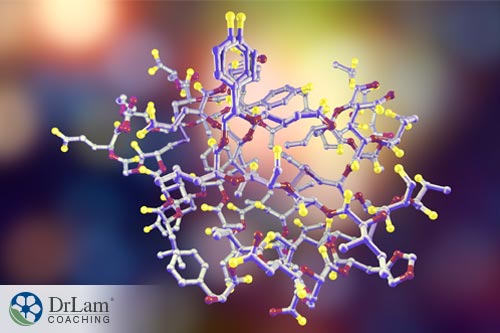 All proteins are not created equal. There are many amino acids, and amino acid combinations, and you must get them from food. The human body needs a number of amino acids in large enough amounts to maintain good health. Amino acids are found in animal sources such as meats, milk, fish, and eggs. Some plants, such as beans, legumes, nut butter, and grains like wheat germ and quinoa, can also be good sources of amino acids.
All proteins are not created equal. There are many amino acids, and amino acid combinations, and you must get them from food. The human body needs a number of amino acids in large enough amounts to maintain good health. Amino acids are found in animal sources such as meats, milk, fish, and eggs. Some plants, such as beans, legumes, nut butter, and grains like wheat germ and quinoa, can also be good sources of amino acids.
There are three classifications of amino acids. They are:
Contrary to what many think, you do not need to eat animal products to get all the protein you need in your diet. There are many plant sources that give you just as much protein as animal products. In fact, many plant proteins offer even more health benefits above and beyond that of typical plant-based protein sources such as soy, legumes, and hemp.
Although an eight-ounce steak provides you with an adequate amount of protein, which your body needs, it also comes with a large amount of saturated fat, which can cause high cholesterol and other problems. On the other hand, many plant proteins provide a healthy source of fat, which is essential in your diet.
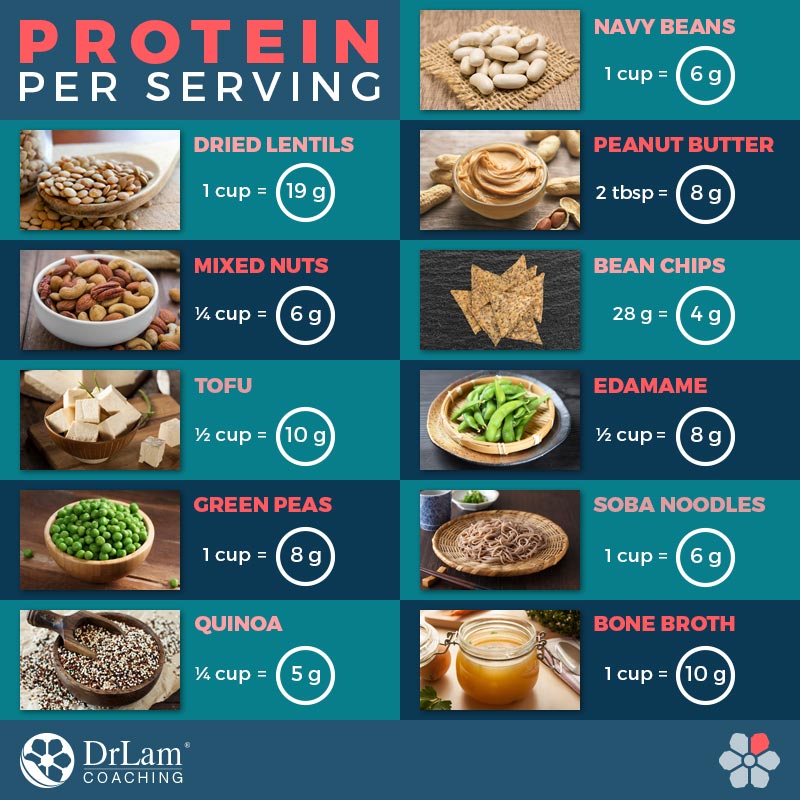
The amount of protein a person needs in their diet varies according to the individual. On average, a healthy adult should consume approximately 10%-35% of their total caloric needs in protein. As an example, a person on a 2000 calorie diet would need 100 grams of protein (at 4 calories per gram) to supply their body with 20% of the daily calorie intake.
The following are a variety of good protein sources and their associated protein per serving content.
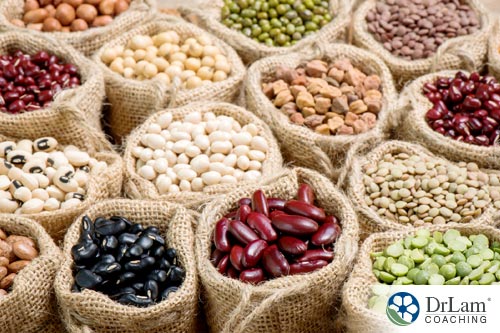 Protein Content: 1 cup is equal to 6 g of protein per serving
Protein Content: 1 cup is equal to 6 g of protein per serving
Beans are an excellent supply of protein per serving. Along with its impressive protein content, one cup of beans also provides 19 grams of dietary fiber.
Protein Content: 1 cup is equal to 19 g of protein per serving
As an easy alternative to beans, lentils don’t require a presoak of any sort. You can simply cook and eat them in 20 minutes. Along with the great protein they provide, their nutrient profile also includes 16 grams of fiber and a vibrant range of minerals.
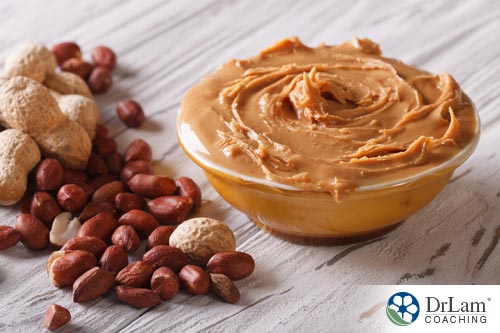 Protein Content: 2 tbsp is equal to 8 g of protein per serving
Protein Content: 2 tbsp is equal to 8 g of protein per serving
Due to its delicious flavor, peanut butter is one of the most popular staples in the protein department, and it’s not just for kids! Peanut butter can be used in sandwiches, on crackers, in cooking, and in protein shakes as well. All natural and organic peanut butter without any sugars or additives is always the best. Some health food stores even allow you to grind your own. Almond butter, sunflower seed, and cashew butter also provide an excellent and tasty source of protein.
Protein Content: ¼ cup has about 6 g of protein per serving
Mixed nuts such as peanuts, cashews, and almonds always make a fun and tasty way to easily add more protein and a healthy source of unsaturated fats to your diet. They are easy to store in bags, purses, and cars for quick snacks. You will want to watch your sodium intake and keep your eyes peeled for labels marked “unsalted,” if needed.
Protein Content: 28 grams has 4 g of protein per serving
It's a rare person who can resist the taste of some crunchy, delicious chips. And with the rise in healthy food options, there are now some great choices on the market to satisfy your taste buds along with your protein needs. Find a protein-rich black bean based chip and a protein-based yogurt, hummus or bean dip, and you are good to go!
Protein Content: ½ cup firm tofu is equal to 10 g of protein per serving
A staple in many countries, tofu is becoming a trendy source of protein in the US, and for great reasons. Tofu contains all eight essential amino acids and is an excellent source of iron, calcium, manganese, selenium, and phosphorus, as well as magnesium, copper, zinc, and vitamin B1. Tofu can be great in stir-fries or on the grill with a great marinade.
Protein Content: ½ cup is equal to 8 g of protein per serving
As a great vegetarian option for protein, shelled soybeans also provide fiber, vitamins, and minerals. Popular as snacks or appetizers, edamame can be enjoyed as is, or seasoned with salt, lemon juice, or smoked paprika.
Protein Content: 1 cup is equal to 8 g of protein per serving
Although most vegetables are full of vitamins and minerals, most lack when it comes to protein. However, green peas are an exception. They are also a good source of fiber. Peas can be a base for many protein shakes and bars. They are the perfect side dish or mixed with pasta and salads.
Protein Content: 1 cup cooked noodles contains 6 g of protein per serving
Soba is Japanese for buckwheat and is a great alternative to conventional pasta. Buckwheat is an ancient grain and contains amino acids, vitamins, minerals, and lots of antioxidants. They have health benefits that include digestive support and cardiovascular health.
Protein Content: ¼ cup dry quinoa contains 5 g of protein per serving
Quinoa is considered the king of all grains, although technically it is a seed. It contains a full panel of essential amino acids, making it a complete protein. It contains twice as much fiber as other grains and has iron, lysine, magnesium, riboflavin, and manganese.
Protein Content: 1 cup contains approximately 10 g of protein per serving
Bone broth comes in at 10 g of protein per cup. Bone broth is getting more publicity as it contains a wide array of nutrients that are difficult to find in other protein sources. They can be mixed with soups, casseroles, in a smoothie, or in baked goods such as muffins, pancakes, and bread.
As the stages of Adrenal Fatigue Syndrome advance, the body loses its ability to metabolize carbohydrates, and insulin resistance is common. Balancing sugar levels becomes very difficult causing fatigue and slumps. By consuming protein-rich foods and including healthy fat sources, the body releases sugar at a much slower pace, preventing sugar highs and lows. Sufferers are then able to ward off lethargy as well as irritability, anxiety, and dizziness. Many of the plant-based proteins, such as mixed nuts and nut butters, are great sources of both protein and fats.
High-protein/low-carb diets are extremely popular, but in some cases, too much protein could do more damage to the body than good. Most people choose this diet for healthy and quick weight loss. When the body receives an excessive amount of protein without enough carbohydrates, it enters into a state called ketosis. The body begins converting its own fat into fuel instead of burning glucose. When the fat is broken down, small bits of carbon are released into the bloodstream. This can cause problems. There is also evidence that people who eat high-protein diets have problems releasing calcium into the bloodstream and excreting it through urine, leading to possible osteoporosis in the future.
Use the protein per serving chart and carefully balance your protein and carbohydrate intake to ensure your wellbeing. Be sure to talk to your doctor before starting a new diet to make sure it’s the right choice for your body and individual circumstances.
People with AFS should never consider partaking in such a high-protein/low carb diet as they must keep their sugar levels balanced at all times to prevent the fatigue that is so commonly a symptom of the illness.
Diets consisting of proteins and good fats are highly recommended for those with adrenal fatigue. Beans, nuts, and lentils provide excellent levels of protein per serving.
